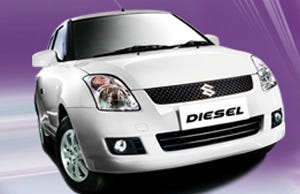India’s Sluggish May Sales Suggest Market ShiftIndia’s Sluggish May Sales Suggest Market Shift
The worry for auto makers with years of product in the pipeline is the market for affordable cars has become stagnant, while light trucks and small-volume luxury vehicles are selling briskly.


MUMBAI – India’s domestic car sales rose 7% in May to 158,817 units, while light trucks deliveries grew 16.3% to 78,828.
But the combined result still only pushes the market’s total light-vehicle sales 9.9% ahead of year-ago to 237,645, Ward’s data shows. Even exports in the month were lackluster, inching up 3.3% to 34,286, according to Society of Indian Automobile Manufacturers.

Maruti-Suzuki to bring new diesel Swift to India to counter high gas prices.
Judging by the global industry’s standard over the last three years, this is a respectable performance. But using the Indian benchmark of 30% annual growth, May’s sluggish performance is cause for concern among the country’s auto makers.
The worry is the market for affordable cars has become stagnant, while small-volume luxury vehicles and light trucks are selling briskly.
Sales of small cars, including those for export, rose only 1.2% last month to 69,282 units. In comparison, deliveries of higher-priced compact and midsize cars, including exports, climbed 32.1% to 30,608.
Super-luxury car sales have seen the most impressive annual growth, from about 2,000 units in 2004 to an estimated 15,000 last year.
Dealers also are feeling the heat as the composition of the Indian market continues to change. Most stocked up in February in anticipation of tax increases that failed to take place and now are saddled with slow-moving inventories, jumping from 20 days’ supply to 45.
Additionally, steep increases in gasoline prices over the last two years have pushed consumers into diesel cars, known for their higher mileage and lower fuel costs.
The price of diesel fuel in India today is 40% less than gasoline, driving sales of diesel cars up to 30% of the domestic market from 20% over the last two years. A Maruti Suzuki spokesman estimates diesel cars will make up half of India’s total annual sales in the next four to five years.
But Volkswagen India Group Sales Director, Neeraj Garg says, “Diesel cars may capture the market in half that period,” while Arvind Saxena, Hyundai India marketing director, expects diesel-car market to grow 7%-8% annually.
Maruti Suzuki is changing its production, with diesel technology available from Volkswagen, thanks to the German auto maker’s tie-up with Suzuki. Maruti plans to introduce Suzuki’s new Swift diesel car here, which currently is sold in Europe.
Recent sales results present widely varying and extremely worrying trends in the performance of India’s big four auto makers. Maruti Suzuki, Hyundai, Tata and Mahindra & Mahindra’s total LV sales in May, including exports, rose 4.1% to 221,676.
Mahindra’s robust 25.4% growth in utilities and light trucks to 27,500 units in the month, including exports, was the result of better inventory management.
Suzuki Maruti, with more than half the market at its command, eked out a 1.0% gain in domestic car deliveries in May, but suffered a 17.3% decline in exports. Hyundai’s domestic car sales rose 14.2%, but its exports tumbled 25.3%.
Tata’s domestic car sales slid 12.6% to 16,280, with poor performances by its flagship Indica and Indigo models. However, Nano sales, soaring 83.4% to 6,515 in May, and light trucks that rose 22.8% to 24,950, helped the auto maker to 5.8% overall growth in domestic LV deliveries.
Among India’s other auto makers, Ford’s domestic car sales in May dropped 12.1%, but exports of its new Figo small car helped it to end the month with a 13% growth to 9,058 units. General Motors managed to keep its LV domestic deliveries flat at 8,292.
Riding on the success of the new Etios sedan and the popularity of its evergreen Innova SUV, Toyota Kirloskar domestic LV sales rose a respectable 23.5% to 7,470 units in May. In contrast, Honda Siel Cars’ deliveries plunged 42.9% to 2,334, although part of that was due to constraints in the supply chain from Japan.
Despite the ongoing shift in consumer preferences, LV sales were up 18% in the year’s first five months. However, India’s auto makers still have reason for concern: First, because they have a combined Rs300 billion ($6.7 billion) of investment in the pipeline over the next three years.
And second, because the LV market is moving away from affordable small cars and towards compacts, sedans, luxury cars and SUVs, while existing capacities are just the reverse.
Read more about:
2011About the Author
You May Also Like